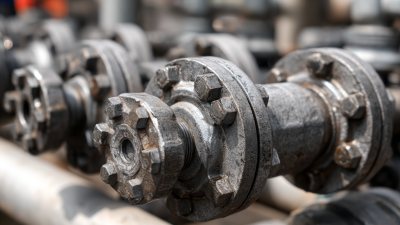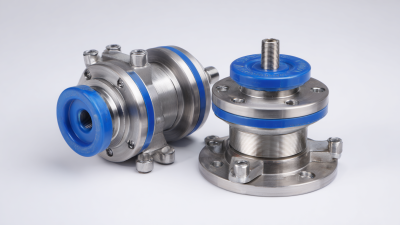Ultimate Guide to Understanding Knife Gate Valves for Industrial Applications
In the realm of industrial applications, the knife gate valve has emerged as a crucial component for effective flow control in various sectors, particularly in slurry handling and wastewater management. According to a recent industry report by MarketsandMarkets, the global knife gate valve market is anticipated to reach approximately $900 million by 2026, growing at a CAGR of 5.7% from 2021. This growth can be attributed to the increasing demand for efficient fluid management solutions in industries such as mining, pulp and paper, and oil and gas. Knife gate valves are distinct for their ability to cut through thick materials, ensuring minimal leakage and maintenance requirements, making them an ideal choice for critical applications. Understanding the nuances of knife gate valves, their applications, and best practices is essential for engineering professionals aiming to optimize operational efficiency and ensure safety in industrial settings.

Understanding the Basics of Knife Gate Valves: Design and Functionality
Knife gate valves are specialized valves designed for applications where the control of flow in large pipelines is essential. Their primary function is to isolate sections of piping, allowing systems to be repaired or maintained without needing to drain entire systems. The design features a sharp-edged gate that slices through the flowing medium—ideal for handling slurries, thick liquids, and even solid materials. This unique mechanism not only provides tight shut-off capabilities but also minimizes the risk of clogging, making them particularly useful in industrial environments.
The construction of knife gate valves varies, but they generally consist of a robust body, a flexible seat, and a blade that moves vertically. The simplicity of their design translates into easy operation and maintenance, a significant advantage in industries such as wastewater treatment and pulp and paper production. Moreover, the materials used in their manufacturing—often stainless steel or other durable metals—ensure longevity and resistance to wear and corrosion. Understanding the design and functionality of knife gate valves is crucial for engineers and operators alike, enabling them to make informed decisions regarding their deployment in industrial applications.
Key Advantages of Knife Gate Valves in Industrial Settings
Knife gate valves have become an invaluable asset in various industrial applications, offering critical advantages that enhance operational efficiency. For industries dealing with slurries, powders, and other media containing solids, knife gate valves provide a robust solution. A report by the International Journal of Industrial Technology indicates that these valves can reduce material waste by up to 25% when optimally integrated into processing lines. Their design allows for a clean cut through the material, minimizing the chances of clogging and ensuring uninterrupted flow.
One significant benefit of knife gate valves is their ability to operate under extreme conditions. According to the 2023 Valve Manufacturers Association report, over 78% of industrial entities prefer knife gate valves for tasks involving high pressures and temperatures. This preference stems from their durable materials and simplistic design, which allow for maintenance without requiring extensive downtime.
**Tips:** When selecting a knife gate valve, consider the type of media and the pressure requirements specific to your application to ensure maximum efficiency. Additionally, regular maintenance checks can extend the lifespan of the valve, allowing for long-term operational benefits.
Ultimate Guide to Understanding Knife Gate Valves for Industrial Applications - Key Advantages of Knife Gate Valves in Industrial Settings
| Feature |
Advantage |
Application |
| Durability |
Resistant to wear and tear in tough environments |
Mining & Mineral Processing |
| Sealing Performance |
Excellent in tight shut-off applications |
Wastewater Treatment |
| Simplicity |
Easy to operate and maintain |
Pulp and Paper Industry |
| Versatility |
Used for various media types |
Chemical Processing |
| Cost-Effective |
Lower long-term maintenance costs |
Food and Beverage Industry |
How to Choose the Right Knife Gate Valve for Your Application
When selecting a knife gate valve for industrial applications, it's essential to consider various factors that impact performance and reliability. According to a recent report from the Industrial Valve Market Insights, the global knife gate valve market is projected to grow at a CAGR of 5.2% over the next five years, driven largely by increased demand from the chemical and wastewater treatment industries. This highlights the importance of choosing a valve that can withstand the specific conditions of your application, such as pressure, temperature, and the nature of the media being handled.
Material selection is another critical aspect when choosing the right knife gate valve. Stainless steel, for instance, is favored for its corrosion resistance, whereas ductile iron is often utilized in applications requiring higher strength and durability. According to the Valve Manufacturers Association, nearly 40% of valve failures can be traced back to inadequate material compatibility with process media. Therefore, investing time in understanding the operational environment and matching the valve materials accordingly can significantly enhance the longevity and efficiency of your system.
Knife Gate Valve Selection Criteria for Industrial Applications
Maintenance Tips for Optimal Performance of Knife Gate Valves
Knife gate valves are essential components in many industrial applications, especially when handling slurries and bulk materials. To ensure optimal performance and longevity of these valves, regular maintenance is crucial. One of the key maintenance tips is to perform periodic inspections of the sealing surfaces and gate edge. Any signs of wear or damage should be addressed promptly, as these can lead to leaks and operational inefficiencies.

Additionally, lubrication plays a significant role in the smooth functioning of knife gate valves. Applying a suitable lubricant to the gate and seat area can reduce friction and prevent premature wear. Operators should also keep the valve body clean from debris and sediment, as buildup can obstruct the gate's movement and hinder performance. By following these simple yet effective maintenance practices, industries can ensure their knife gate valves operate at peak efficiency, ultimately contributing to a smoother overall process in their operations.
Common Issues and Troubleshooting Techniques for Knife Gate Valves
Knife gate valves are essential components in numerous industrial applications, yet they often encounter specific issues that can hamper their performance. One common problem is leaking, which may arise due to worn seals or improper installation. To address this, ensure regular maintenance checks and replace any damaged seals promptly. Additionally, proper alignment during installation is crucial to prevent excessive wear and tear.
Another frequent issue with knife gate valves is jamming or failure to open and close smoothly. This can happen due to debris accumulation or corrosion within the valve body. A practical tip is to implement routine cleaning schedules to keep the valves free of obstructions. Using a lubricant specifically designed for industrial valves can also help facilitate smoother operations and prolong their service life.
Lastly, operators should be vigilant about unusual noises during valve operation, which can indicate potential problems. If you hear grinding or scraping sounds, it may be time to inspect the valve's internals and perform necessary repairs. Preventative maintenance, including regular inspection and timely repairs, can significantly enhance the longevity and reliability of knife gate valves in industrial settings.

 © Copyright 2020 Tianjin Tanghaidongyang Valve Co., Ltd. All Rights Reserved.
© Copyright 2020 Tianjin Tanghaidongyang Valve Co., Ltd. All Rights Reserved.










